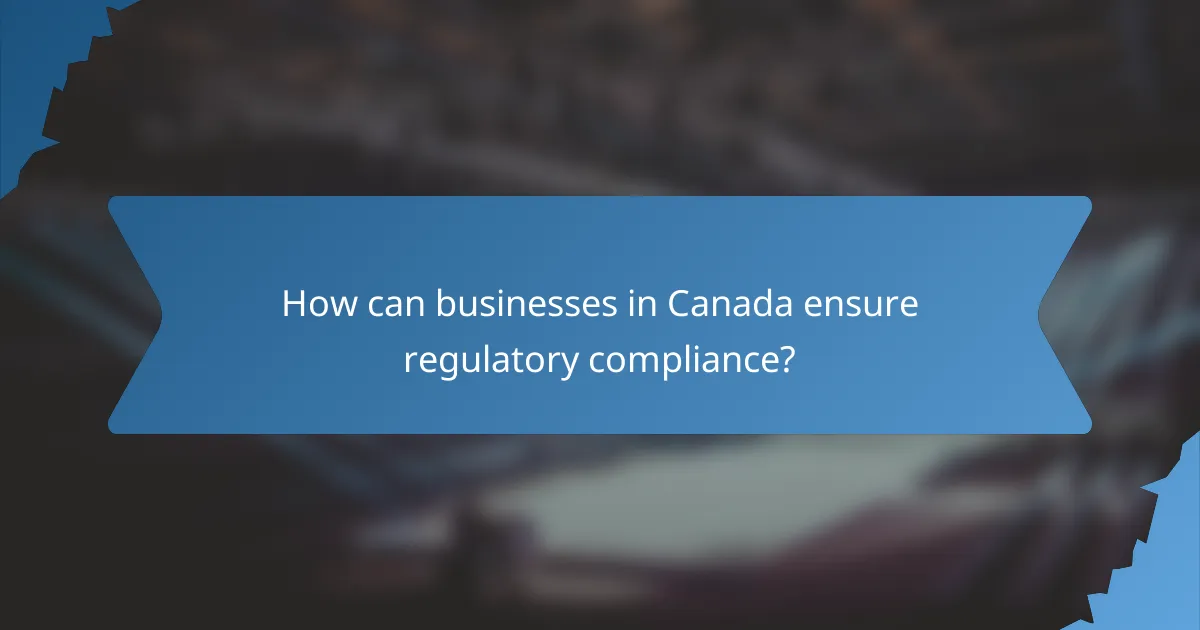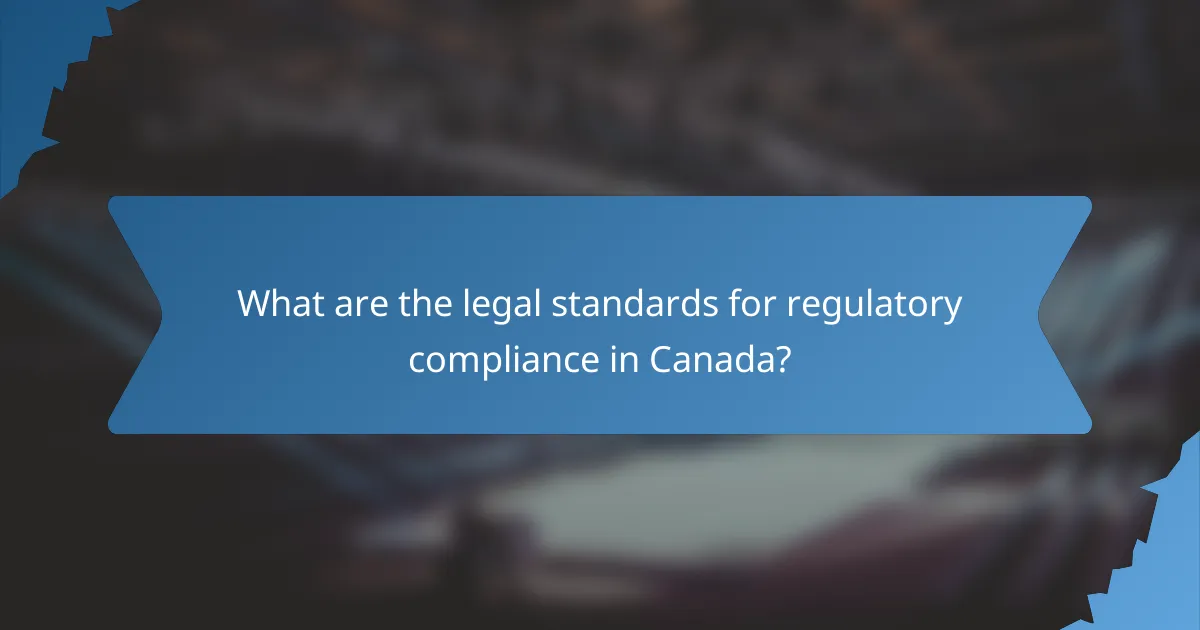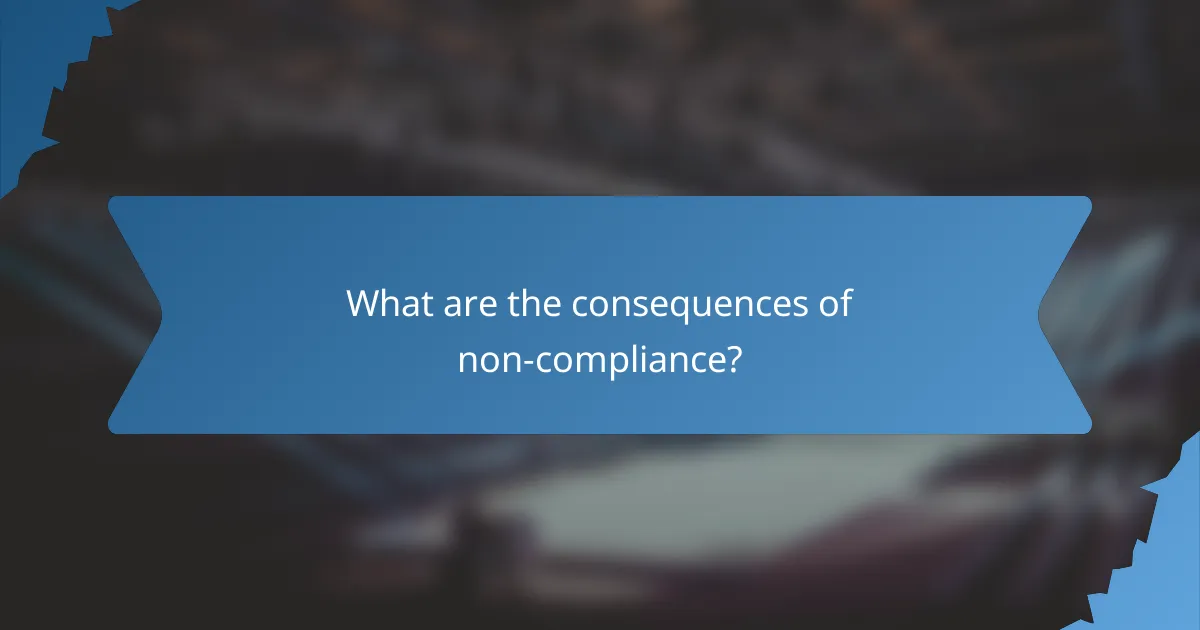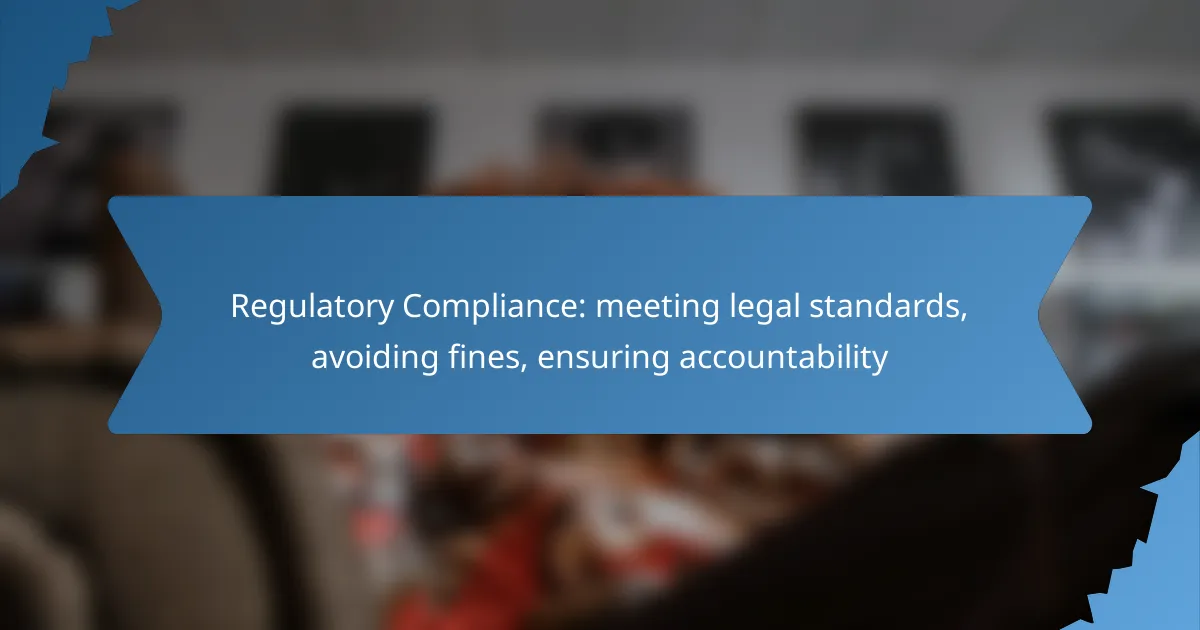Regulatory compliance is essential for businesses in Canada to meet legal standards and avoid potential fines. By implementing structured systems, conducting regular audits, and engaging legal experts, organizations can ensure accountability and protect their reputation. Understanding key regulations, such as CASL and PIPEDA, is crucial for navigating the complexities of compliance and mitigating risks associated with non-compliance.

How can businesses in Canada ensure regulatory compliance?
Businesses in Canada can ensure regulatory compliance by implementing structured systems, conducting audits, engaging legal experts, training employees, and utilizing compliance software. These strategies help organizations meet legal standards, avoid fines, and maintain accountability.
Implement compliance management systems
Compliance management systems (CMS) provide a framework for organizations to manage their regulatory obligations effectively. These systems help identify applicable laws, track compliance activities, and document processes. A well-implemented CMS can reduce risks and streamline compliance efforts.
Consider integrating policies and procedures that align with Canadian regulations, such as the Personal Information Protection and Electronic Documents Act (PIPEDA) for data privacy. Regularly updating these systems is crucial to adapt to changing regulations.
Conduct regular audits
Regular audits are essential for assessing compliance with legal standards. These audits can be internal or external and should evaluate processes, documentation, and adherence to regulations. Conducting audits at least annually can help identify gaps and areas for improvement.
When planning audits, focus on high-risk areas specific to your industry. For instance, financial institutions may prioritize anti-money laundering compliance, while healthcare organizations might focus on patient privacy regulations.
Engage legal counsel
Engaging legal counsel is vital for navigating the complexities of regulatory compliance. Lawyers with expertise in corporate law can provide guidance on applicable regulations and help interpret legal requirements. This support is particularly important when facing regulatory changes or potential compliance issues.
Consider establishing a retainer agreement with legal experts to ensure timely access to advice and support. This proactive approach can prevent costly legal challenges and fines.
Provide employee training
Employee training is crucial for fostering a culture of compliance within an organization. Regular training sessions ensure that staff members understand their responsibilities regarding regulatory requirements. Tailor training programs to specific roles and compliance areas relevant to your business.
Utilize a mix of training methods, such as workshops, e-learning, and simulations, to engage employees effectively. Regularly updating training materials to reflect changes in regulations is also essential.
Utilize compliance software
Compliance software can significantly enhance an organization’s ability to meet regulatory requirements. These tools automate compliance processes, track obligations, and generate reports, saving time and reducing errors. Many software solutions are designed to address specific industries or regulatory frameworks.
When selecting compliance software, consider factors such as scalability, user-friendliness, and integration capabilities with existing systems. Investing in the right technology can streamline compliance efforts and improve overall efficiency.

What are the legal standards for regulatory compliance in Canada?
In Canada, regulatory compliance involves adhering to various legal standards designed to protect individuals and ensure fair practices. Key regulations include the Canadian Anti-Spam Legislation (CASL), the Personal Information Protection and Electronic Documents Act (PIPEDA), and the Occupational Health and Safety Act (OHSA), each addressing specific areas of compliance.
Canadian Anti-Spam Legislation (CASL)
The Canadian Anti-Spam Legislation (CASL) regulates how businesses can communicate electronically with consumers. It requires organizations to obtain consent before sending commercial electronic messages, including emails and texts. Non-compliance can result in significant fines, so understanding consent requirements is crucial.
To comply with CASL, businesses should maintain clear records of consent and provide easy opt-out options in communications. A best practice is to regularly review and update consent forms to ensure they meet legal standards.
Personal Information Protection and Electronic Documents Act (PIPEDA)
PIPEDA governs how private sector organizations collect, use, and disclose personal information in Canada. It mandates that organizations obtain consent for collecting personal data and outlines individuals’ rights to access and correct their information. Compliance with PIPEDA is essential for maintaining consumer trust and avoiding penalties.
Organizations should implement robust privacy policies and training programs to ensure employees understand their responsibilities under PIPEDA. Regular audits can help identify compliance gaps and improve data handling practices.
Occupational Health and Safety Act (OHSA)
The Occupational Health and Safety Act (OHSA) sets out the rights and duties of employers and workers to ensure a safe working environment. Compliance involves identifying hazards, implementing safety measures, and providing training to employees. Failure to comply can lead to serious legal repercussions and workplace injuries.
Employers should conduct regular safety audits and engage employees in safety training programs. Establishing a clear reporting system for safety concerns can also enhance compliance and promote a culture of safety within the organization.

What are the consequences of non-compliance?
Non-compliance with regulatory standards can lead to significant repercussions, including financial penalties, legal challenges, and damage to an organization’s reputation. Understanding these consequences is crucial for maintaining accountability and avoiding costly mistakes.
Fines and penalties
Fines and penalties are among the most immediate consequences of non-compliance. Regulatory bodies may impose monetary fines that can range from hundreds to millions of dollars, depending on the severity of the violation and the specific regulations involved. For example, companies in the financial sector may face hefty fines for failing to adhere to anti-money laundering laws.
To mitigate the risk of fines, organizations should regularly conduct compliance audits and ensure that they stay updated on relevant laws. Establishing a compliance program can help identify potential issues before they result in penalties.
Legal action and lawsuits
Non-compliance can also lead to legal action, including lawsuits from affected parties or regulatory authorities. This legal exposure can result in costly litigation, settlements, or judgments that further strain an organization’s resources. For instance, a data breach due to non-compliance with data protection regulations could lead to lawsuits from customers whose information was compromised.
To avoid legal repercussions, organizations should implement robust compliance training for employees and establish clear reporting mechanisms for potential violations. Legal counsel should be consulted when navigating complex regulatory environments.
Reputational damage
The reputational damage from non-compliance can be long-lasting and detrimental to an organization’s brand. Customers and partners may lose trust, leading to decreased sales and a tarnished public image. For example, a company that is fined for environmental violations may face backlash from consumers who prioritize sustainability.
To protect reputation, organizations should prioritize transparency and proactive communication regarding compliance efforts. Engaging with stakeholders and demonstrating a commitment to ethical practices can help rebuild trust after a compliance failure.

What frameworks help in achieving compliance?
Several frameworks can assist organizations in achieving regulatory compliance, ensuring they meet legal standards while avoiding fines. These frameworks provide structured approaches to managing quality and security, which are essential for accountability.
ISO 9001 Quality Management
ISO 9001 is a widely recognized standard that focuses on quality management systems (QMS). It helps organizations ensure they consistently meet customer and regulatory requirements, which is crucial for maintaining compliance.
Implementing ISO 9001 involves establishing a QMS that includes processes for continuous improvement, customer feedback, and performance evaluation. Organizations should document their processes, conduct regular audits, and engage employees in quality initiatives to enhance compliance.
Common pitfalls include neglecting employee training and failing to review processes regularly. To avoid these issues, organizations should create a checklist for QMS implementation that includes training schedules, audit timelines, and feedback mechanisms.
ISO 27001 Information Security Management
ISO 27001 provides a framework for establishing, implementing, maintaining, and continually improving an information security management system (ISMS). This standard is essential for organizations that handle sensitive information and need to comply with data protection regulations.
To achieve compliance with ISO 27001, organizations must assess their information security risks, implement appropriate controls, and regularly review their security measures. This includes conducting risk assessments, developing security policies, and training staff on security best practices.
Organizations should be cautious about underestimating the importance of ongoing monitoring and review of their ISMS. A practical tip is to set up a regular review cycle, ensuring that security measures adapt to emerging threats and changing regulations.

How to stay updated on regulatory changes?
Staying updated on regulatory changes is essential for compliance and avoiding penalties. Regularly monitoring legal updates, industry news, and participating in professional networks can help ensure you remain informed about relevant laws and standards.
Subscribe to legal updates
Subscribing to legal updates from reputable sources is a straightforward way to keep informed about regulatory changes. Many law firms and compliance organizations offer newsletters that summarize recent developments in various sectors.
Consider setting up alerts for specific regulations or topics relevant to your industry. This proactive approach allows you to receive timely information, helping you adjust your practices as needed.
Join industry associations
Joining industry associations can provide valuable insights into regulatory changes affecting your sector. These organizations often host events, webinars, and forums where members discuss compliance challenges and share best practices.
Membership may also grant access to resources such as compliance toolkits and legal guidance tailored to your industry. Engaging with peers can enhance your understanding of how to navigate evolving regulations effectively.
